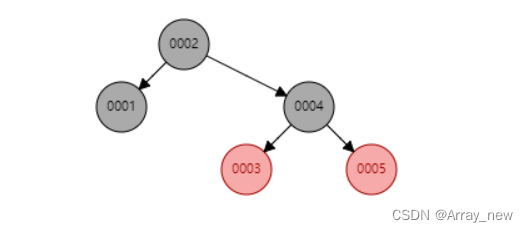在hashmap中最重要的就是增加和删除,在1.8的hashMap中引入了TreeNode在1.7的hashMap原来的数组加链表的基础加入了红黑树,使得hashMap的查询性能大幅增长,而且相比与之前的头插法来说使用了尾插法,避免了可能会出现的死循环问题。
1.8 hashMap源码和个人的一些见解:
public V put(K key, V value) {
return putVal(hash(key), key, value, false, true);
}
/**
* Implements Map.put and related methods.
*
* @param hash hash for key
* @param key the key
* @param value the value to put
* @param onlyIfAbsent if true, don't change existing value
* @param evict if false, the table is in creation mode.
* @return previous value, or null if none
*/
final V putVal(int hash, K key, V value, boolean onlyIfAbsent,
boolean evict) {
Node<K,V>[] tab; Node<K,V> p; int n, i;
if ((tab = table) == null || (n = tab.length) == 0)
//Node数组的初始化与扩容
n = (tab = resize()).length;
if ((p = tab[i = (n - 1) & hash]) == null)
//判断插入的位置是否为空,为空直接new一个对象
tab[i] = newNode(hash, key, value, null);
else {
//原位置中存在数据
Node<K,V> e; K k;
//如果与数组目标位置的第一个元素相等进行value替换
if (p.hash == hash &&
((k = p.key) == key || (key != null && key.equals(k))))
e = p;
//如果目标位置的元素是树的结点,将其放到树中
else if (p instanceof TreeNode)
e = ((TreeNode<K,V>)p).putTreeVal(this, tab, hash, key, value);
else {
//不是树遍历循环到最后节点(尾插法)
for (int binCount = 0; ; ++binCount) {
if ((e = p.next) == null) {
p.next = newNode(hash, key, value, null);
if (binCount >= TREEIFY_THRESHOLD - 1) // -1 for 1st
//先插入数据再判断是否要转换成树的结构,放入时实际的链表长度为9;
treeifyBin(tab, hash);
break;
}
//遍历过程中继续判断是否与新的key相同
if (e.hash == hash &&
((k = e.key) == key || (key != null && key.equals(k))))
break;
p = e;
}
}
if (e != null) { // existing mapping for key
V oldValue = e.value;
if (!onlyIfAbsent || oldValue == null)
e.value = value;
afterNodeAccess(e);
return oldValue;
}
}
++modCount;
if (++size > threshold)
resize();
afterNodeInsertion(evict);
return null;
}
//初始化和扩容操作
final Node<K,V>[] resize() {
Node<K,V>[] oldTab = table;
int oldCap = (oldTab == null) ? 0 : oldTab.length;
int oldThr = threshold;
int newCap, newThr = 0;
if (oldCap > 0) {
if (oldCap >= MAXIMUM_CAPACITY) {
threshold = Integer.MAX_VALUE;
return oldTab;
}
//容量大小左移一位,新出现的数组是原来的二倍,扩容后的遍历原数组数据原数组的目标的索引只可能在原位或(原位+原容量)所在的索引位
else if ((newCap = oldCap << 1) < MAXIMUM_CAPACITY &&
oldCap >= DEFAULT_INITIAL_CAPACITY)
newThr = oldThr << 1; // double threshold
}
else if (oldThr > 0) // initial capacity was placed in threshold
newCap = oldThr;
else { // zero initial threshold signifies using defaults
newCap = DEFAULT_INITIAL_CAPACITY;
newThr = (int)(DEFAULT_LOAD_FACTOR * DEFAULT_INITIAL_CAPACITY);
}
if (newThr == 0) {
float ft = (float)newCap * loadFactor;
newThr = (newCap < MAXIMUM_CAPACITY && ft < (float)MAXIMUM_CAPACITY ?
(int)ft : Integer.MAX_VALUE);
}
threshold = newThr;
@SuppressWarnings({"rawtypes","unchecked"})
Node<K,V>[] newTab = (Node<K,V>[])new Node[newCap];
table = newTab;
if (oldTab != null) {
for (int j = 0; j < oldCap; ++j) {
Node<K,V> e;
if ((e = oldTab[j]) != null) {
oldTab[j] = null;
if (e.next == null)
newTab[e.hash & (newCap - 1)] = e;
else if (e instanceof TreeNode)
((TreeNode<K,V>)e).split(this, newTab, j, oldCap);
else { // preserve order
Node<K,V> loHead = null, loTail = null; //生成低位头节点和低位尾节点
Node<K,V> hiHead = null, hiTail = null;//生成高位头节点和高位尾节点
Node<K,V> next;
//循环遍历生成俩个链表或红黑树
do {
next = e.next;
if ((e.hash & oldCap) == 0) {
if (loTail == null)
loHead = e;
else
loTail.next = e;
loTail = e;
}
else {
if (hiTail == null)
hiHead = e;
else
hiTail.next = e;
hiTail = e;
}
} while ((e = next) != null);
if (loTail != null) {
loTail.next = null;
newTab[j] = loHead;
}
if (hiTail != null) {
hiTail.next = null;
newTab[j + oldCap] = hiHead;
}
}
}
}
}
return newTab;






 本文解析了Java 1.8中HashMap的工作原理,包括其内部结构的变化、红黑树的应用以及尾插法的实现方式,重点介绍了putVal方法的具体流程。
本文解析了Java 1.8中HashMap的工作原理,包括其内部结构的变化、红黑树的应用以及尾插法的实现方式,重点介绍了putVal方法的具体流程。

















 232
232

 被折叠的 条评论
为什么被折叠?
被折叠的 条评论
为什么被折叠?










